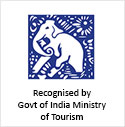Places to see in Rajasthan
Rajasthan, in north western India, is a kaleidoscope of royalty and vivid imagery. A land of magnificent palaces and huge forts, with a rich history filled with tales of courage and sacrifice of the Rajputs. The golden sand dunes, the desert safaris, fair and festivals, the palaces, with the colorfully dressed folk musicians and dancers all make the state mysterious enough to be visited..
Tourist Guide for Rajasthan Tour
Hawa Mahal, Jaipur:
Constructed by Maharaja Sawai Pratap Singh in 1799, the 'Hawa Mahal' or Palace of the Wind is Jaipur's prime landmark. Built as an extension of the Zenana, women's chamber standing away from the main city palace, this five storey building of unusual architecture is a stunning example of Rajput artistry made of red and pink honeycomb sand stone. The windows are beautifully outlined with white borders and motif's painted with quick lime. The monument was originally conceived with the purpose of enabling ladies of the royal household to view the everyday life and kingly processions in the city without being noticed by others. A small archaeological museum is also there on the same site.
Jaisalmer Fort, Jaisalmer:
The Great Fort stands tall 100 m over the city and in fact houses a bastion within its massive ramparts. Walking down the narrow cobbled stone lanes, travelers can feel and sense the true magic of Jaisalmer. Several entrances called Pols, including the Ganesh Pol, Suraj Pol, Bhoota Pol and the Hava Pol guard the Megh Durbar and the Jawahar Mahal which were till late occupied by the royal family The Jaisalmer Fort is popularly known as the Golden Fort for its amber hue, which mesmerizes every tourist to the place.
Keoladeo National Park, Bharatpur:
Far from the city of Bharatpur lies the Keoladeo Park ,thought to be one of the world's outstanding heronries. Enclosing an area of 12 square miles, it is an interlocking ecosystem of woodlands, swamps, wet prairies and dry savannah and was earlier the hunting ground for the KIngs of Bharatpur. The Sanctuary houses over 370 varieties of birds of which more than 115 species are migrants flying in from Central Asia, Siberia and Western China during the winter months.
Umaid Bhawan Palace, Jodhpur :
Nestled within the depths of the thar desert and flanked on the western side by the Mehrangarh fort and to the eastern side by the stately sandstone, the palace of Umaid Bhawan was built by Maharaja Umaid Singh who ruled from 1911 to 1947. It was the last expression of princely architectural extravaganza built during the British Raj. Also known as Chittar Palace, the palace is a splendid example of Indo-colonial architecture.
The Junagarh Fort, Bikaner:
The fort is a formidable structure confined by a moat and has some beautiful palaces within. The palaces, made in red sandstone and marble makes up a perfect picture in the background of courtyards, balconies, Kiosks and windows that are dotted all over the structure. Built by Akbar's general Raja Singh in 1593 AD, the notables of the Palace Fort are the exquisitely beautiful Chandra Mahal with marvellous painting mirrors and carved marble panels, and the Phool Mahal ornately decorated with glass and mirror work. Other palaces in Bikaner worth visiting are the Anup Mahal, Karan Mahal, Dungar Niwas, Ganga Niwas, Gaj Mandir and Rang Mahal.
Dargah Khwaja Moin-ud-din Chisti, Ajmer :
The Dargah is in the honour of the Sufi saint Khwaja Moinuddin Chisti who came to India from Persia with the invasion of Mohammad Ghori in the year 1192. The shrine is second in importance than the Holy Mecca to the Muslims and creation started by the then Sultan of Delhi Altamash . The great mughal Emperor Humayun finished the construction of the Dargah left unfinished by the earlier sultan. It was a venue of an annual pilgrimage undertaken by Akbar the great.









